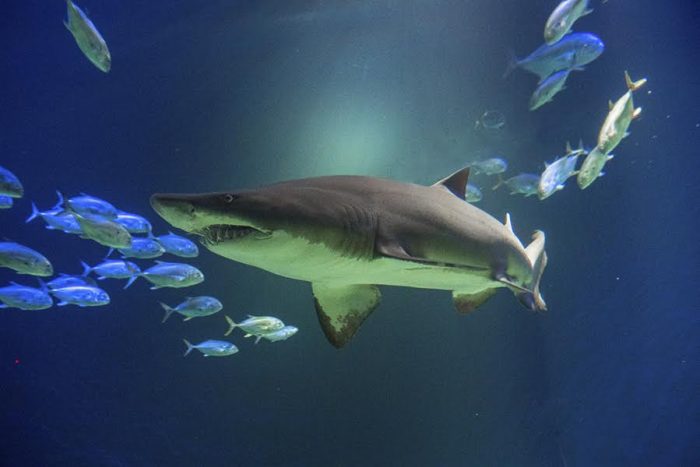News from SBU: What’s the real story about shark populations in New York Waters?

Scientists call for more research and key steps to gathering evidence around human-shark interactions, perspective published in Journal of Fish Biology
The lack of evidence about shark biology, their prey, and changes in the ecosystems of New York area coastal waters is a driving force to expand research about sharks and their populations in the region, so say a team of scientists in an article published in the Journal of Fish Biology.
As the 2023 summer season wraps up and marine biologists look to a new season and coming summers, the perspective piece challenges an emerging view that there is a growing number of human-shark interactions in the New York Bight (a triangular coastal region encompassing ocean and bay waters from New Jersey to the NYC metro area and Long Island) – all this because of growing shark populations and their feeding habits.
Lead author Oliver N. Shipley, PhD, a Research Assistant Professor in the School of Marine and Atmospheric Sciences (SoMAS) at Stony Brook University, and colleagues describe the current knowledge of shark biology in the region and detail the misalignment between scientific knowledge and anecdotal information reported in recent years in the media about sharks in the region. They provide several critical areas for future research that they hope will promote positive attitudes of sharks and their conservation and help mitigate future human-shark conflicts.
“Shark populations are poorly studied in the New York Bight. When human-shark interactions occur, this paucity of scientific data has resulted in inaccurate messages from some mainstream media trying to assign causality to these incidents,” says Shipley. “We are calling for steps to be taken to advance scientific knowledge in order to better understand shark populations and why human-shark interactions may be occurring.”
According to the authors, population declines of sharks and their relatives have been well documented over the last several decades, globally, primarily because of targeting fishing and bycatch from commercial and recreational fisheries. Yet in the temperate waters of the New York Bight, sharks have received heighted attention due to a reported increase in their activity close to the shore. And the complex relationship between sharks and humans has been further ignited by a recent spike in human-shark interactions along the coastal New York Bight.
The authors write: “Although we acknowledge both sightings of sharks and reporting of negative human-shark interactions has increased in recent years, assigning any immediate causality would be irresponsible and risky to both sharks and human stakeholders in the absence of scientific support.”
To counter the easily perceived immediate causality to the human-shark encounters, Shipley and colleagues recommend that going forward the following research avenues are necessary to gather evidence about shark populations in the region:
There needs to be an expansion of coastwide monitoring programs in the context of climate change. They suggest shark monitoring methods can include multiple approaches, such as coastal drone surveys, environmental DNA assessments, and robust spatial analyses that quantify interactions between climate and sharks, and their prey across time.
Michael Frisk, PhD, a Professor at SoMAS and senior author on the paper, explains that such surveys would lead to novel long-term data that can be used to assess the distribution of sharks in response to prey movements and environmental conditions. It would also help to better understand the environmental conditions that increase the potential overlap between sharks and humans, and therefore help to gauge the possibilities of such encounters and potentially reduce or prevent them.
At SoMAS, several research groups are undertaking research that examines so-called “hotspots” of shark-prey interactions along southern Long Island, and where these may be impacted by warming ocean conditions.
Shipley says he and fellow researchers intend to begin systematic drone surveys at several pilot beaches to support townships and state shark monitoring initiatives, in hopes of providing new data on the probability of human-shark overlap and what conditions may drive such overlap.
Co-authors of the position paper include: Michael G. Frisk of SoMAS; Jill A. Olin of the Great Lakes Research Center, Michigan Technological University; Christopher Scott, Division of Marine Resources, New York Department of Environmental Conservation; and Merry Camhi, of the New York Seascape Program at the New York Aquarium and Wildlife Conservation Society.






